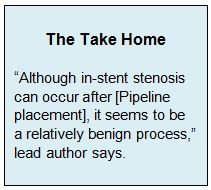Key Points:
- Retrospective analysis assesses in-stent stenosis after flow diversion using Pipeline stent
- In-stent stenosis occurred in fewer than 1 in 10 patients, caused no clinical sequelae
In-stent stenosis is uncommon and likely a benign event among patients treated with flow diversion for intracranial aneurysm, according to a small, retrospective analysis published online November 20, 2015, ahead of print in Neurosurgery.
Investigators led by Gabor Toth, MD, of the Cleveland Clinic (Cleveland, OH) conducted a retrospective analysis of 80 patients who underwent treatment with the Pipeline Embolization Device (Covidien) between June 2011 and April 2015.
The researchers used angiography to identify the presence of in-stent stenosis, defined as an area of parent vessel narrowing. Mean follow-up duration was 12.5 months. Most often focal, cases were graded as mild (25%-50%), moderate (50%-75%), or severe (>75%). They also assessed for the presence of intimal hyperplasia, defined as a uniform growth process beyond the limits of the metallic mesh at > 25%.
In-stent restenosis was detected at a median of 6 months in 5 of the 51 patients (9.8%) with available angiographic follow-up. 9.8% of this subgroup. Four out of those 5 cases (80%) were mild, with 1 moderate case and no severe cases observed. “None of the in-stent stenoses caused flow limitation, clinical symptoms, or required re-treatment,” the paper notes, adding, “All patients were managed medically with no change in their dual antiplatelet regimen.”
Sixteen patients (31%) had intimal hyperplasia, and 28 patients (55%) had no evidence of stenosis.
Additional follow-up angiography was available in 2 of the 5 patients with in-stenosis patients and showed “marked improvement” by approximately 2 years.
‘Part of the Healing Process’
“There has been a lot of recent interest in flow diverter technology,” Dr. Toth told WLNCMD in a telephone interview. “Some people call it a paradigm shift, but a lot of people don’t know what happens with the stent long term.” Not much has been published specific to the Pipeline device, he added.
“What we think our study shows is that although in-stent stenosis can occur after placement of this device, it seems to be a relatively benign process,” continued Dr. Toth. “There is no severe vessel narrowing associated with it. Clinically, it doesn’t seem to cause significant symptoms or stroke or require therapy.”
Alexander L. Coon, MD, of Johns Hopkins University School of Medicine (Baltimore, MD), explained to WLNCMD that the terms “in-stent stenosis” is a bit of a misnomer in the context of flow diversion for intracranial aneurysm, because it implies the presence of occlusion that is not likely to exist.
“This is an artifact of the neo-endothelialization process, and what we’ve seen—and I’ve personally done over 400 [cases]—is that when this does happen, and it’s rare. It’s typically self-limited,” he said in a telephone interview. “It’s very different from in-stent restenosis as it occurs in the coronary literature.”
While operators do attempt to minimize in-stent stenosis in this context, by properly placing and deploying the device and optimizing antiplatelet therapy, “it’s part of the healing process, so it’s a fine balance,” he stressed. “We want this process to occur.”
Both physicians agreed that interpretation of the study is limited by its small size, so additional research is required to confirm the findings. However, it does suggest that angiographic follow-up among asymptomatic patients to look for the presence of in-stent stenosis is not necessary in the clinical setting, since it generally does not present a problem and often resolves on its own if it does occur. Management of symptomatic patients would need to be determined on a case-by-case basis, depending on such factors as patient age, location and type of aneurysm, and specific symptomatology, Dr. Coon advised.
Source:
John S, Bain M, Hui F, et al. Long-term follow-up of in-stent stenosis after Pipeline flow diversion treatment of intracranial aneurysms. Neurosurgery. 2015;Epub ahead of print.
Disclosures:
- Dr. Toth reports no relevant conflicts of interest.
- Dr. Coon reports being proctor for all 3 flow diverters available in the United States, including Pipeline, SILK, and Surpass.


